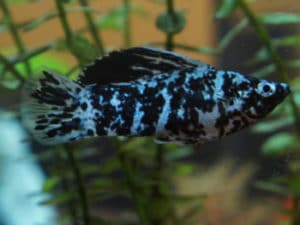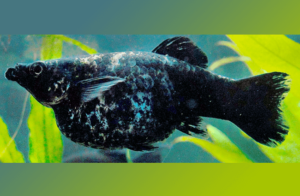Molly fish, or just mollies, are freshwater fish from the genus Poecilia, in the Poeciliidae family. These little fish are available in many different colors and patterns and will surely add a fun note of color to your aquarium. Encourage to learn all about them

There are many varieties of Molly fish, some from nature and others from numerous crosses between different species.
Table Of Content
Taxonomy 🐟
Animalia Kingdom Phylum: Chordata Class: Actinopterygii Order: Cyprinodontiformes (Rivulines, killifishes and live bearers)
Family: Poeciliidae Genre: Poecilia Species: P. sphenops
Importance of Marine Biodiversity.🐟
Large numbers of endangered species are concentrated in the sea but due to destruction of marine habitat, acidification of the oceans (caused by the dumping of nitrogen waste and sediments) and climate change many of them are disappearing. Thus, the future of the oceans (71% of the planet) could end without animal life and without marine biodiversity.
When it’s too late, we will realize the importance of the sea as a potential source of medicines, chemicals, cosmetics, raw materials, and fuel and biochemical systems.
We are loading the oceans, when it’s still estimated that there are more than 1,400,000 unknown species. Only 0.1% of the sea is in a protected area.
Every one of us can collaborate to slow down the climate change preserving this way «Our marine species”. The earth is our only home so far!
Characteristics of Molly Fish 🐟
Wild-type mollies are mostly silver in color with a little color on the fins. However, you won’t find many of these in pet stores, since almost all commercially available molly fish are mass-raised hybrids in captivity.
Selective reproduction has produced an endless variety of colors, fin shapes and even body shapes. Many of these are the result of the crossing of short-finned Poecilia sphenops with Poecilia latipinna, also known as sailfin molly.
The female molly fish can grow to a maximum size of about 12 cm while the male molly fish can reach up to 8 cm.
Molly fish are freshwater fish of the genus Poecilia, of the family Poeciliidae. All species of this genus are mollies, except Endler’s life carrier.
There are currently 40 species in this genus, so 39 of them are mollies. These fish are native to the Americas, but their habitat can vary significantly.
An interesting fact about molly fish is that they keep their eggs inside their body until they can give birth to live young directly in the water.
They are a very popular group of fish. Most species are resistant and easy to care for, which makes them ideal for beginners. They work well in peaceful community aquariums. If you stay in a healthy environment, a group of mollies will thrive and can live up to 5 years.
It’s rare that you find a fish shop that doesn’t sell mollies; they are one of the most popular freshwater fish.
Let’s watch them
Https://www.youtube.com/watch?v=94TaMjTRuu4
Is there Sexual Dimorphism in Molly Fish?
In Molly fish, sex can be differentiated after 2 or 3 months of life. This is great information, if we want to establish a Mollys breeding program, or maintain a good balance in the aquarium.
These are the main morphological differences between male and female Mollys:
✅ Anal fin. The anal fin is the one near the tail, in the ventral area (below). Males Molly fish
Have a tube-shaped elongated fin which is their reproductive organ: the gonopodium. In females, the anal fin is fan-shaped.
✅ Size. Males usually measure between 5 and 8 centimeters long, while females can reach even 12 cm centimeters.
✅ Body shape Females have a more rounded body than males, more stylized, thin and elongated.
✅ Coloration. Molly males have more striking and bright colors than females.
Let’s learn
Distribution and Habitat
Molly fish can be found in many parts of the world, although they are native to the southeastern United States, Venezuela and Colombia to Mexico. It’s known about isolated populations in some Caribbean islands.
They are fish that usually live in the mouths of the rivers, so they endure a certain degree of salinity in the water.
It’s not usual that we buy a Molly bred in freedom, which we will find in pet stores, are fish raised in China or in Eastern Europe, only to be sold.
Varieties of Molly Fish
There are lots of molly fish varieties – most are very similar to the common molly (Poecilia sphenops). The main differences are colors and patterns, but sizes and shapes can differ too.
Poecilia sphenops
Also known as Mollienesia and Common Molly Fish, This fish belongs to the order of cyprinodontiformes.
It’s a water fish that inhabits from Mexico to Colombia in waters near the sea. Males tend to be smaller, but more elongated and their fins have a greater growth than those of females.
The Common Molly Fish, has a maximum length of six centimeters while the female measures 10 centimeters, which means that there is a marked sexual dimorphism in the species molly fish.
Feeding
Poecilia sphenops Is omnivorous, so its food is varied. It can eat live, dried food, some scales, among others although young specimens must be fed with water fleas, crushed scales, etc.
Behavior
This type of molly fish is very peaceful, although adult males can become territorial with other fish in the aquarium. It’s necessary that these fish live in groups of one male for every three or five females. It’s common for this fish to clean algae in the aquarium and they get along with other species of equal size.
Let’s meet them
Https://www.youtube.com/watch?v=vChuffytQhE
Sailfin molly (Poecilia latipinna)
The body of the sailfin molly is essentially oblong. It also has a highly developed dorsal fin (especially males) and rectangular in shape when deployed.
There is sexual dimorphism in this species since the female measures around 15 centimeters as well as a long dorsal fin that differs from the previous species: Common Molly Fish. On the other hand the male measures 10 centimeters in length and its dorsal fin has a shape sailing
Distribution
Poecilia latipinna can be found from the coastal regions of the southeastern United States to  the Yucatan Peninsula in Mexico.
the Yucatan Peninsula in Mexico.
It’s worth mentioning that it has been introduced in several regions of the United States (California, Nevada …) and Hawaii. This species prefers marshes, lowland streams, swamps, and estuaries; the sailfin molly is very common in peninsular Florida.
Coloration
The body is generally light gray, although breeding males may be greenish-blue. Several rows of spots occur along the sides, back, and dorsal fin.
Often times these spots blend together or are very close to one another, creating an appearance of stripes. Aquarists have developed many color variations in this species, and indeed much variation occurs naturally in the wild, with melanistic and speckled forms known.
Interesting data
✅ The sailfin molly, in its many color varieties is of considerable interest and value to aquarists and many artificially selected varieties are produced and sold in pet shops. Naturally occurring populations of sailfin mollies may help to control mosquito populations by feeding on the larvae and pupae of these pests.
✅ This species is not listed as threatened or vulnerable by the World Conservation Union (IUCN). The IUCN is a global union of states, governmental agencies, and non-governmental organizations in a partnership that ass the common molly.
Let’s watch them
Black molly 🐟
This is one of the most popular and decorative fish in tropical aquariums. It’s important to mention that almost all black mollies will be born with a serious case of melanism, which is a skin condition opposite to albinism (the lack of color pigmentation).
While the majority of Black Molly fish are completely black, they can sometimes be found with a streak of yellow which runs down the dorsal fin or a slight silvery color on the flanks.
The black molly can exceed 10 cm in length, although commonly traded types rarely exceed 7 cm.
The elongated and fusiform body has a beautiful opaque black color, although some exceptional dorsal sail-shaped males have a reddish or orange trim on the upper margin of such appendix.
Sexual dimorphism is evident, since in addition to the characteristic gonopod or transformed anal fin of the male, females are usually larger and more rounded.
 It’s important to point out that there are numerous types and varieties coming from crosses of the original races, presenting very common forms of ‘lyre tail’.
It’s important to point out that there are numerous types and varieties coming from crosses of the original races, presenting very common forms of ‘lyre tail’.
The native species come from the southern United States, Mexico, Colombia and Venezuela, living in brackish, calm and richly planted waters.
How long do they usually live?🐟
Three-four years on average, although there is evidence of specimens that have survived longer.
What do you need?🐟
They require large aquariums, minimum 60 l, with ample free spaces, abundantly planted in quantity and variety, with water of medium to medium high hardness of 15-25DH and slightly alkaline to frankly alkaline, pH 7-8.2.
The temperature can range from 22 to 28C, the optimum being 24 or 25C. They prefer abundant lighting and decoration free of sharp rocks. The sandy bottoms adapt perfectly to the habitat of the species. It’s convenient to dissolve 1 g of fat salt per liter of water in the tank.
Character and behavior 🐟
Peaceful and sociable, they can live with other related species such as xifos, guppys, platys, etc., but require large free spaces and amphitheaters configured and separated by luxuriant underwater vegetation.
Let’s enjoy them
Green swordtail 🐟
The Green swordtail is also known as Xiphophorous Hellerii in scientific terms. This curious freshwater creature has a cheerful and friendly temperament and is native to Central and North America.
It owes its name to the appearance of its tail that, although it may seem so, is not used as an offensive weapon. Its tail is simply the extension of the caudal fin of the male.
The tail of the Green swordtail can reach up to 15 centimeters in length when they are in their natural habitats. However, in a community aquarium the male reaches around 10 centimeters and females 12 centimeters.
The body of this molly fish species is adapted to the feed on the surface of the water. For this reason, its mouth is oriented upwards and their elongated body provides them with stability when swimming.
It worth pointing out that the female swordtail fish is larger than the male, and the differences between the two are very evident. females lack the characteristic ‘sword tail’, nor do they have the gonopodium, which is the reproductive adaptation of the anal fin.
However, there are cases in which adult females can develop male characteristics. In fact, this sexual inversion is very common in this species.
Swordtail fish feeding
In their natural state, swordtail fish are omnivorous. They usually feed on a wide variety of insects, invertebrates, plant matter and algae. When they are kept in a home aquarium, this diet should be reproduced as accurately as possible.
 The most important portion of their diet should consist of high quality flakes. In addition, swordtail fish eat bleached vegetables and live or frozen foods.
The most important portion of their diet should consist of high quality flakes. In addition, swordtail fish eat bleached vegetables and live or frozen foods.
Preferred vegetables are usually zucchini medallions, cucumber medallions, peas, and broccoli.
All vegetables should be bleached in boiling water first, then let them cool and give them to the fish.
On the other hand, the best live foods to feed a sword tail are daphnia or water fleas. In addition, they enjoy black worms, brine shrimp, and mosquito larvae or fruit mosquitoes. Its flavor in frozen foods can be quite similar. For this reason, frozen foods are also a good option to feed your fish.
Let’s enjoy them
Is there a Mickey Mouse Molly fish?🐟
It’s important to clarify at this point that many people get to confuse molly fish with platys, given the similarity of their appearance.
One of the most frequent confusions has given rise to the false rumor about the existence of a molly mickey mouse fish, which It turns out to be a fish that has three dark spots in its tail that people relate to the famous cartoon.it’s worth clarifying that it’s not a kind of molly, but a Platy.
Care of Molly fish in Aquariums.🐟
They are fish that adapt to any size of aquarium but it’s preferable one where they can swim comfortably. A 10 gallon aquarium would be suitable for up to four depending on the species – larger mollies like the sailfins will need a 30 gallon tank.
It’s worth mentioning that molly fish are peaceful and sociable; remember to place several females, (at least 3 per male) since the latter are very active and will harass them until stressed.
The water temperature should be around 26ºC .
They get to live for 2 to 3 years.
Water quality 🐟
A tropical fish like this needs a heater in the tank to maintain temperatures of 23-26 ° C. Keep the pH between 6.7 and 8.5, and the hardness between 20-30 KH.
 Your Molly fish aquarium should always be filtered, heated and fully cycled. Like most life bearers, unlike many other popular species of aquarium fish, mollys don’t appreciate soft and acidic water.
Your Molly fish aquarium should always be filtered, heated and fully cycled. Like most life bearers, unlike many other popular species of aquarium fish, mollys don’t appreciate soft and acidic water.
Another interesting and much debated point is the salt of the water.
Most aquarists keep their mollies in freshwater facilities and have no idea that their fish can really thrive in brackish or even marine waters.
While fresh water should be fine, (as long as the water quality is high), many molly keepers say their fish seem healthier with some added salt. We invite you to read our article fish for fish tanks to learn more about aquariums.
Decorations 🐟
Provide your Molly fish with lots of plant-shaped hiding places, but make sure you keep an open space so they can swim freely.
Vallisneria is an easy plant that should work well for larger aquariums and that can handle the high pH needs of the Mollies.
Behavior 🐟
They are a peaceful group most of the time, but they can show signs of aggression when surrounded by aggressive partners. Therefore, it’s important that your aquarium is large enough and that they have suitable tank mates.
Mollies are active and social, so they enjoy education together. A shoal must be predominantly feminine since it’s known that males harass and stress females.
Compatible Fish with Molly Fish 🐟
Molly fish are a very popular option for community aquariums, but unfortunately keeping them with other tropical fish is not always the best idea.
 They are very active and are known to be a little fussy at times, which makes them a bad combination with very calm or long-finned fish.
They are very active and are known to be a little fussy at times, which makes them a bad combination with very calm or long-finned fish.
Water quality is another point, because as discussed earlier, most aquarium fish prefer softer and acidic water, while mollys need hard water and a high pH.
Good aquarium companions for molly fish include other live carriers such as guppies, as these can also handle high salinity and harder water.
Apart from that, the toughest fish that prefer or at least can handle similar water values should work. Cherry Barbo (Puntius titteya) could be a good combination in freshwater settings.
Feeding Molly Fish.🐟
Molly fish are omnivorous creatures which can eat everything although they prefer vegetable food such as seaweed. Food on scales isn’t a bad option for this species although food of plant origin will be always the most suitable option for them.
How molly Fish Reproduce.🐟
For mating, 3 to 4 females per male must be placed in the aquarium. The mature male will mate with the females and the incubation period is about 30 days depending on the temperature of the water: the hotter the shorter the birth period.
The number of offspring is variable depending on many factors such as water and their genetic background ranging from 20 to 200, but the common are about 60 fry.
Molly fish are ovoviviparous that is to say that the female has the eggs internally and they release them when they hatch.
These fry are very small so you must have enough algae to hide from the larger fish, starting with their mother.
There is always the option of placing the mother in a plastic cage that they sell in stores, the mother is placed and when the fry are born they must be moved into the cage but the mother not.
This ovoviviparous behavior makes breeding less problematic, fish that lay eggs, such as cyclics, are more careful and delicate. This makes the Molly an ideal fish for beginners.
Let’s watch and learn
